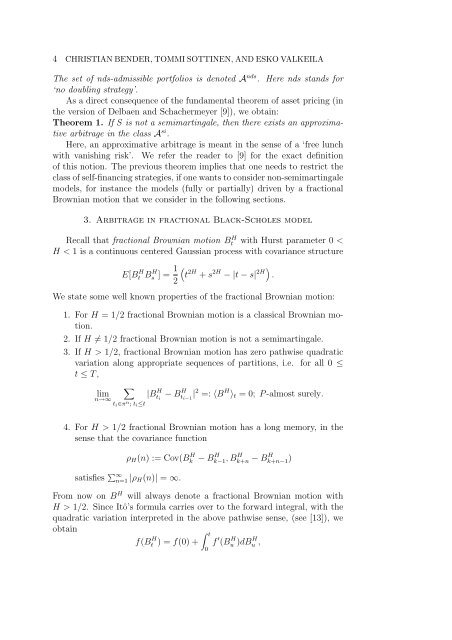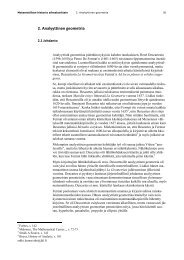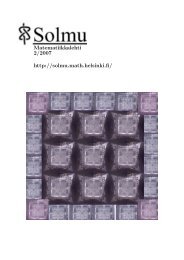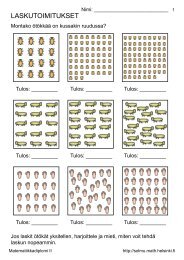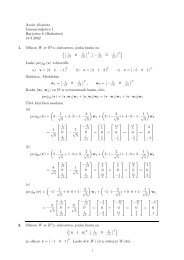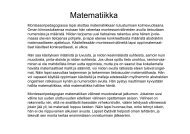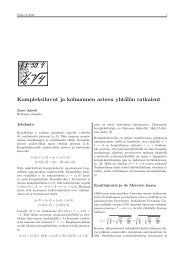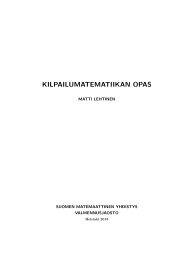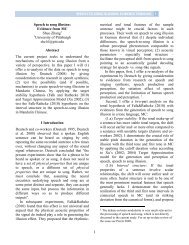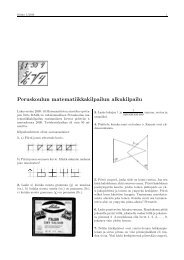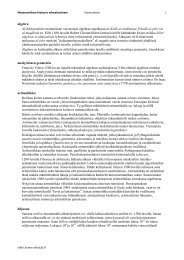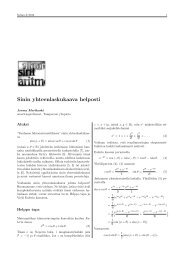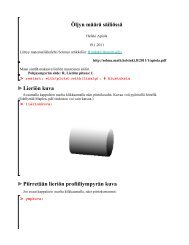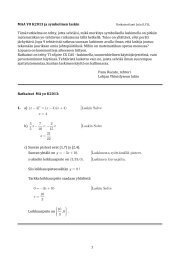ARBITRAGE WITH FRACTIONAL BROWNIAN MOTION?1 - Helsinki.fi
ARBITRAGE WITH FRACTIONAL BROWNIAN MOTION?1 - Helsinki.fi
ARBITRAGE WITH FRACTIONAL BROWNIAN MOTION?1 - Helsinki.fi
Create successful ePaper yourself
Turn your PDF publications into a flip-book with our unique Google optimized e-Paper software.
4 CHRISTIAN BENDER, TOMMI SOTTINEN, AND ESKO VALKEILA<br />
The set of nds-admissible portfolios is denoted A nds . Here nds stands for<br />
‘no doubling strategy’.<br />
As a direct consequence of the fundamental theorem of asset pricing (in<br />
the version of Delbaen and Schachermeyer [9]), we obtain:<br />
Theorem 1. If S is not a semimartingale, then there exists an approximative<br />
arbitrage in the class A si .<br />
Here, an approximative arbitrage is meant in the sense of a ‘free lunch<br />
with vanishing risk’. We refer the reader to [9] for the exact de<strong>fi</strong>nition<br />
of this notion. The previous theorem implies that one needs to restrict the<br />
class of self-<strong>fi</strong>nancing strategies, if one wants to consider non-semimartingale<br />
models, for instance the models (fully or partially) driven by a fractional<br />
Brownian motion that we consider in the following sections.<br />
3. Arbitrage in fractional Black-Scholes model<br />
Recall that fractional Brownian motion B H t with Hurst parameter 0 <<br />
H < 1 is a continuous centered Gaussian process with covariance structure<br />
E[B H t B H s ] = 1 2<br />
(<br />
t 2H + s 2H − |t − s| 2H) .<br />
We state some well known properties of the fractional Brownian motion:<br />
1. For H = 1/2 fractional Brownian motion is a classical Brownian motion.<br />
2. If H ≠ 1/2 fractional Brownian motion is not a semimartingale.<br />
3. If H > 1/2, fractional Brownian motion has zero pathwise quadratic<br />
variation along appropriate sequences of partitions, i.e. for all 0 ≤<br />
t ≤ T ,<br />
lim<br />
∑<br />
n→∞<br />
t i ∈π n ; t i ≤t<br />
|B H t i<br />
− B H t i−1<br />
| 2 =: 〈B H 〉 t = 0; P -almost surely.<br />
4. For H > 1/2 fractional Brownian motion has a long memory, in the<br />
sense that the covariance function<br />
ρ H (n) := Cov(B H k<br />
− B H k−1, B H k+n − B H k+n−1)<br />
satis<strong>fi</strong>es ∑ ∞<br />
n=1 |ρ H (n)| = ∞.<br />
From now on B H will always denote a fractional Brownian motion with<br />
H > 1/2. Since Itô’s formula carries over to the forward integral, with the<br />
quadratic variation interpreted in the above pathwise sense, (see [13]), we<br />
obtain<br />
∫ t<br />
f(Bt H ) = f(0) + f ′ (Bu H )dBu H ,<br />
0


